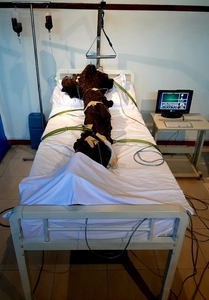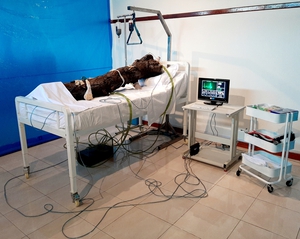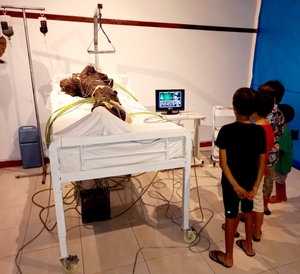A Dying Tree
This is a hospital bed in which Camilio laid a tree trunk of 180cm long, which is roughly his high. The tree is connected to a heart monitor, water / oxygen and a drip. In this work we see a dead trunk in a bed, to focus on what we normally not see – the tree trunk represents deforestation, and the damages being inflicted to the environment as a whole (and the global warming it is inflicting), but also the artist and his fears.
dated 2020 until 2020
(click on an image to enlarge an artwork)
send a message

A Dying Tree
2020A Dying Tree This is a hospital bed in which Camilio laid a tree trunk of 180cm long, which is roughly his high. The tree is connected to a heart monitor, water / oxygen and a drip. In this work we see a dead trunk in a bed, to focus on what we normally not see – the tree trunk represents deforestation, and the damages being inflicted to the environment as a whole (and the global warming it is inflicting), but also the artist and his fears. As you can hear, the heart monitor makes a heartbeat sound, but is going into a flatline, as the work is called: A dying tree. The debate over the damage we have been inflicting on earth – and the consequences it will have to our lifestyles and, ultimately, to the survival of the human race, are portrayed in this installation as they have reappeared with renewed power in Camilio’s mind. The diminished impact in the environment as the world was forced to stop (if only for a little) with Covid-19 pandemic has been revealing to the massive damage we have been causing to the environment in the Anthropocene era – the most recent period in Earth’s history when human activity started to have a significant impact on the planet’s climate and ecosystems. Although this classification, proposed in 2000 by biologist Eugene Stormer and chemist Paul Crutzen, hasn’t been officially accepted yet, Camilio draws upon it to propose a reflection about humanity’s past, present, and future – and about the price of our action/inaction.

A Dying Tree
2020A Dying Tree This is a hospital bed in which Camilio laid a tree trunk of 180cm long, which is roughly his high. The tree is connected to a heart monitor, water / oxygen and a drip. In this work we see a dead trunk in a bed, to focus on what we normally not see – the tree trunk represents deforestation, and the damages being inflicted to the environment as a whole (and the global warming it is inflicting), but also the artist and his fears. As you can hear, the heart monitor makes a heartbeat sound, but is going into a flatline, as the work is called: A dying tree. The debate over the damage we have been inflicting on earth – and the consequences it will have to our lifestyles and, ultimately, to the survival of the human race, are portrayed in this installation as they have reappeared with renewed power in Camilio’s mind. The diminished impact in the environment as the world was forced to stop (if only for a little) with Covid-19 pandemic has been revealing to the massive damage we have been causing to the environment in the Anthropocene era – the most recent period in Earth’s history when human activity started to have a significant impact on the planet’s climate and ecosystems. Although this classification, proposed in 2000 by biologist Eugene Stormer and chemist Paul Crutzen, hasn’t been officially accepted yet, Camilio draws upon it to propose a reflection about humanity’s past, present, and future – and about the price of our action/inaction.

A Dying Tree
2020A Dying Tree This is a hospital bed in which Camilio laid a tree trunk of 180cm long, which is roughly his high. The tree is connected to a heart monitor, water / oxygen and a drip. In this work we see a dead trunk in a bed, to focus on what we normally not see – the tree trunk represents deforestation, and the damages being inflicted to the environment as a whole (and the global warming it is inflicting), but also the artist and his fears. As you can hear, the heart monitor makes a heartbeat sound, but is going into a flatline, as the work is called: A dying tree. The debate over the damage we have been inflicting on earth – and the consequences it will have to our lifestyles and, ultimately, to the survival of the human race, are portrayed in this installation as they have reappeared with renewed power in Camilio’s mind. The diminished impact in the environment as the world was forced to stop (if only for a little) with Covid-19 pandemic has been revealing to the massive damage we have been causing to the environment in the Anthropocene era – the most recent period in Earth’s history when human activity started to have a significant impact on the planet’s climate and ecosystems. Although this classification, proposed in 2000 by biologist Eugene Stormer and chemist Paul Crutzen, hasn’t been officially accepted yet, Camilio draws upon it to propose a reflection about humanity’s past, present, and future – and about the price of our action/inaction.

A Dying Tree
2020A Dying Tree This is a hospital bed in which Camilio laid a tree trunk of 180cm long, which is roughly his high. The tree is connected to a heart monitor, water / oxygen and a drip. In this work we see a dead trunk in a bed, to focus on what we normally not see – the tree trunk represents deforestation, and the damages being inflicted to the environment as a whole (and the global warming it is inflicting), but also the artist and his fears. As you can hear, the heart monitor makes a heartbeat sound, but is going into a flatline, as the work is called: A dying tree. The debate over the damage we have been inflicting on earth – and the consequences it will have to our lifestyles and, ultimately, to the survival of the human race, are portrayed in this installation as they have reappeared with renewed power in Camilio’s mind. The diminished impact in the environment as the world was forced to stop (if only for a little) with Covid-19 pandemic has been revealing to the massive damage we have been causing to the environment in the Anthropocene era – the most recent period in Earth’s history when human activity started to have a significant impact on the planet’s climate and ecosystems. Although this classification, proposed in 2000 by biologist Eugene Stormer and chemist Paul Crutzen, hasn’t been officially accepted yet, Camilio draws upon it to propose a reflection about humanity’s past, present, and future – and about the price of our action/inaction.